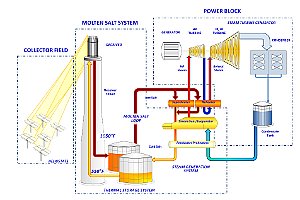 The Rice Solar Energy Project will produce enough electricity to meet the demand of 60,000 households—about 150 megawatts—beginning in 2013. Click here for a full-size version of the diagram. Courtesy of SolarReserve.
The Rice Solar Energy Project will produce enough electricity to meet the demand of 60,000 households—about 150 megawatts—beginning in 2013. Click here for a full-size version of the diagram. Courtesy of SolarReserve.
In a world energy landscape dominated by coal, gas, oil, and nuclear, renewable energy sources such as wind and solar don’t stand a chance if we can’t find a way to store energy when the sun doesn’t shine and the wind doesn’t blow. In my last blog entry, I wrote about storing electric energy in a battery made of paper and nanotech ink (see The Paper Battery Chase). But it isn’t necessary to store electric energy. We can create hydrogen, using electricity generated from photovoltaic panels, and then use the hydrogen to fuel a fuel cell, which recreates the electricity. The Leaf Community in Italy is experimenting with this process. And energy changes forms in other ways. We can store heat from the sun and use it to create electricity in the dark. As in any energy storage and conversion process, if we can do it without losing too much energy in the process, we can add another tool to our renewable energy toolbox.
I add a little salt to the water when cooking spaghetti—it raises the boiling point so that you can cook the pasta more quickly, although I’m not sure it makes a big difference. Mostly I add salt to make the spaghetti taste better. The properties of a liquid salt—a mixture of sodium nitrate and potassium nitrate—are a little different. This liquid salt will store heat up to a temperature of 1,0000F, which is much higher than the boiling point of water, 2120F at sea level. The Pacific Gas and Electric Company, (PG&E) has contracted with SolarReserve LLC to store energy using liquid salt. The Rice Solar Energy Project will produce enough electricity to meet the demand of 60,000 households—about 150 megawatts—beginning in 2013.
The Rice Project uses a large circular field of mirrors to reflect light onto a central tower. Liquid salt is circulated through the tower and, once heated, it is stored in an insulated tank. When the sun goes down the liquid salt will still be able to heat water well past the boiling point to create steam, which can be fed into a conventional steam turbine to produce—Walla—electricity. The liquid salt, now cooled, is stored in another tank and is ready to begin the process all over again.
Take that coal, gas, oil, and nuclear!
